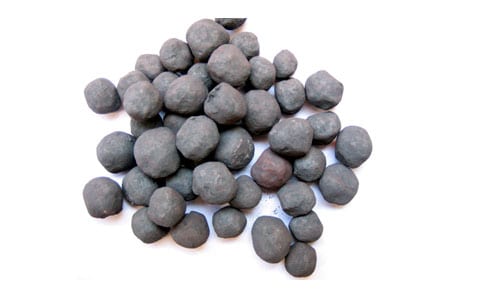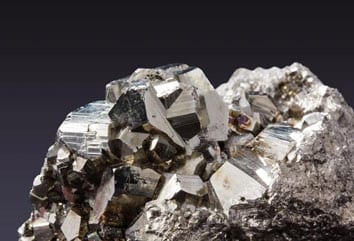Fè chwa lang:
Iron ore is the fourth most common element in the earth’s crust. Iron is essential to steel manufacturing and, se poutèt sa, an essential material for global economic development. An fè tou lajman ki itilize nan konstriksyon ak manifakti nan machin yo. Most iron ore resources are composed of metamorphosed banded iron formations (BIF), nan ki fèt an fè ki pa te jwenn nan fòm D', hydroxides, ak, to a lesser extent, carbonates.
The chemical composition of iron ores is apparent to be wide, especially for Fe content and associated gangue minerals. Major iron minerals associated with most iron ores are hematite, goethite, limonite, and magnetite. Pwensipal contaminants nan minerais an fè yo SiO2 ak Al2O3. The typical silica and alumina-bearing minerals present in iron ores are quartz, kaolinite, gibbsite, dyaspore, e corundum. Sa yo, it is often observed that quartz is the main silica-bearing mineral, and kaolinite and gibbsite are the two main alumina-bearing minerals.


Iron ore extraction is mainly performed through open pit mining operations, sa siyifi résidus pitit an pitit. An fè minrè pwodiksyon sistèm dabitid enplike estaj twa: min, pwosesis, and pelletizing activities. Processing ensures that an adequate iron grade and chemistry are achieved prior to the pelletizing stage. Otomatik gen ladann kraze, klasifikasyon, fraisage, and concentration, with the aim of increasing the iron content while reducing the amount of gangue minerals. Each mineral deposit has its own unique characteristics with respect to iron and gangue-bearing minerals, and therefore, it requires a different concentration technique.
Magnetic separation is typically used in high-grade iron ore beneficiation, where the dominant iron minerals are ferro and paramagnetic. Mouye, yon tè sèk ba entansite mayetik separasyon (AGIL) techniques are used to process ores with strong magnetic properties, such as magnetite, while wet high-intensity magnetic separation is used to separate the Fe-bearing minerals with weak magnetic properties, such as hematite, from gangue minerals. Iron ores such as goethite and limonite are commonly found in tailings and do not separate very well by either technique.

Flotation se itilize diminye kontni an nan enpurte nan ba-klas fe ores. An fè minerais kapab konsantre swa pa dirèk flottaison anioniques D' fèt an fè, ni opoze cationiques flottaison de silice; Sepandan, reverse cationic flotation remains the most popular flotation route used in the iron industry. The use of flotation is limited by the cost of reagents, the presence of silica and alumina-rich slimes, and the presence of carbonate minerals. Anplis, flotation requires wastewater treatment and the use of downstream dewatering for dry final applications.
The use of flotation for the concentration of iron also involves desliming, as floating in the presence of fines results in decreased efficiency and high reagent costs. Desliming patikilyèman kritik pou retire D' kòm separasyon gibbsite nan hematite oubyen goethite pa yon ajan yo-jan sa dwe fèt difisil. Most alumina-bearing minerals occur in the finer size range (<20um), pou retire li nan desliming. Tout, yon gwo konsantrasyon nan amand (<20um) ak alumina ogmante doz la ajan basophil egzije ak diminye selectivity dramatikman. Se poutet sa, desliming increases flotation efficiency but results in a large volume of tailings and in loss of iron to the tailings stream.
Pwosesis sek nan ore fe, prezante yon opotinite yo elimine depans ak mouye jenerasyon tailings ki asosye ak flotation ak mouye mayetik separasyon sikui. STET has evaluated several iron ore tailings and run-of-mine ore samples at bench scale (echel pre-posibilite). Mouvman enpotan nan fe ak silicates te obseve, ak egzanp ki make nan tablo ki anba a.

Rezilta sa yo nan etid sa a demontre ke ka ki ba-klas fe yo kapab modenize pa vle di nan STET tribo-electrostatic senti séparation. Baze sou eksperyans STET, Rekiperasyon an pwodwi ak/oswa klas pral siyifikativman amelyore nan pwosesis echel Pilot, kom konpare ak aparey la tes ban-echel itilize pandan ese sa yo ore fe.
The STET dry electrostatic fine iron ore separation process offers many advantages over traditional wet processing methods, tankou magnetics oswa flotation, Enkli:
Contact us to learn more about dry processing of iron ore.
Referans:
Iron ore beneficiation involves a series of processes that aim to improve the purity and quality of raw iron ore. These processes include crushing, fanm ki ap pile, separasyon mayetik, flotan, and gravity separation, depending on the mineralogical characteristics of the ore. Each technique is selected based on the ore’s composition and feasibility to extract the maximum amount of iron while minimizing impurities.
Iron ore mining requires specialized equipment to handle the extraction and processing of ore. Common machinery includes ball mills for grinding, crushers for reducing the size of ore, magnetic separators for separating iron particles from impurities, flotation machines for fine particle separation, and conveyors for transport.
Technologies utilized for iron ore beneficiation include advanced techniques such as dry electrostatic separation, flotan, advanced gravity separation, and sensor-based sorting. These technologies aim to efficiently increase the iron content and eliminate contaminants, catering to the growing demand for high-grade iron ore and promoting sustainable mining practices.
The cost of iron ore beneficiation can vary significantly depending on the specific processes and technologies used, the grade of the raw ore, and the desired purity of the final product. It encompasses capital expenditure (CAPEX), such as equipment and plant construction, and operational expenditure (OPEX), including labor, Eneji, e konsomasyon. It’s essential for companies to evaluate these costs against prospective revenue and market demands to ensure project viability.